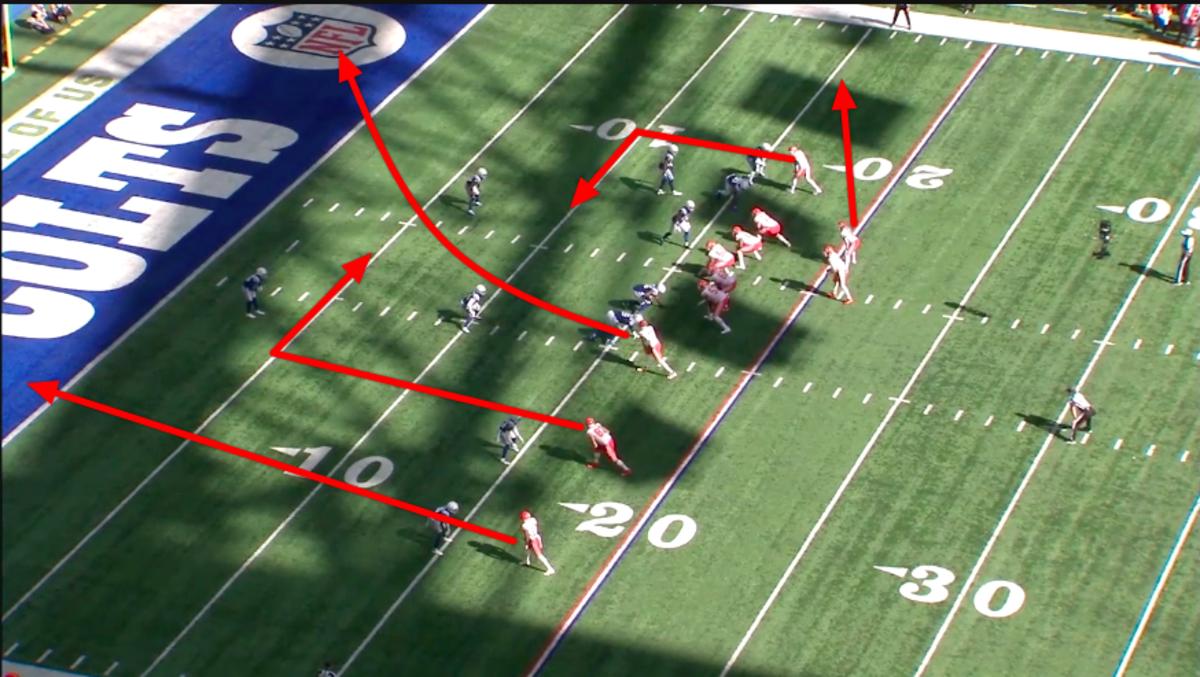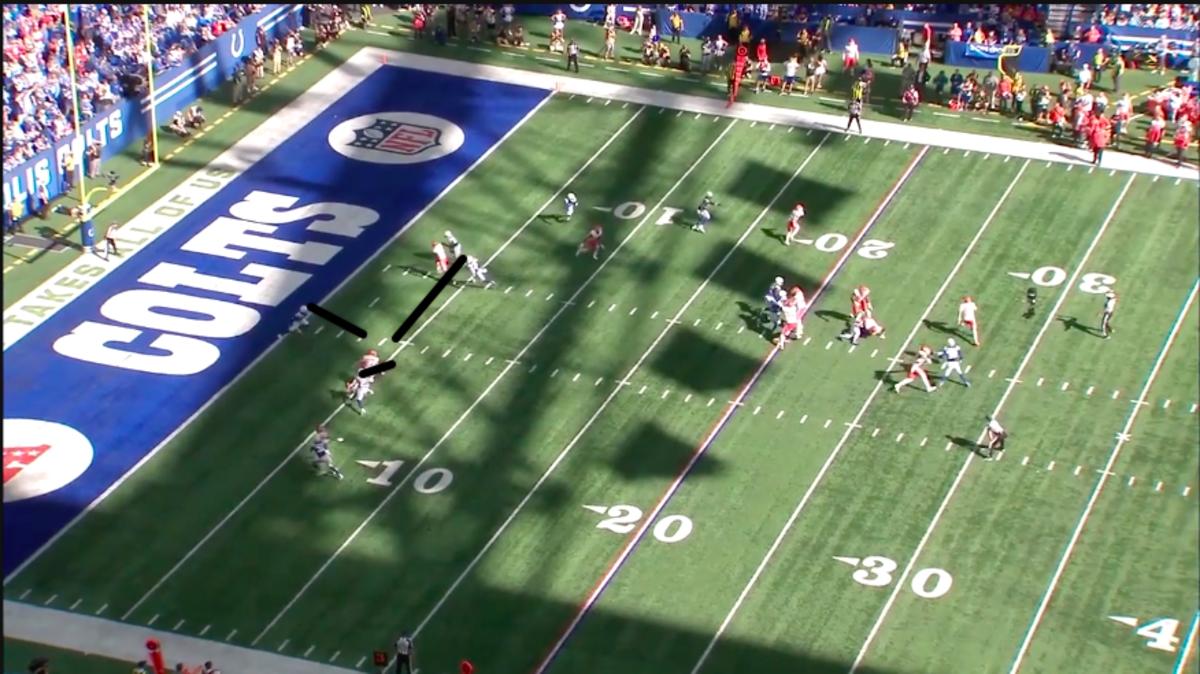Gus Bradley Shows Play-Calling Versatility in Colts' Win over Chiefs: Film Room
The Indianapolis Colts pulled off the upset over the Kansas City Chiefs this past weekend. While the Colts' offense is still a work in progress, it was Indy's defense that really stepped up to the plate in this one. Defensive Coordinator Gus Bradley's unit held former MVP Pat Mahomes to a passer rating of just 78.5 and a completion percentage of 57% in this game.
In the week leading up to the match-up with the Chiefs, Bradley did give hints at to what his defense was going to do to disrupt the Chiefs' passing game:
Obviously, a quarterback like this, mixing up the looks, doing different things but playing fast. They do a great job of getting their receivers the ball, their backs the ball to operate in space. We’re going to have to do a good job regardless, whatever we’re playing of doing a good job tackling in space, giving some different looks and then execution.
After reviewing the film, it is pretty easy to see that Bradley came into this game with the mindset of playing tougher coverages and diversifying his looks on the backend. In today's film room, I dive into a few different coverage calls he made that disrupted the vaunted Chiefs' passing attack.
Cover Two
The Colts were primarily a split safety, cover-two base defense under former Defensive Coordinator Matt Eberflus. While that has already changed to more of a single-high safety team under Gus Bradley, the team did go back to their roots a bit against Pat Mahomes and the Chiefs.
From my personal charting, I counted the Colts' in split safety looks on 36% of the snaps on Sunday. While that still means that the Colts were in single-high on 64% of the snaps, this is the most that Bradley has elected to use two-high safeties in 2022 with the Colts.
One of the coverages that he went to in this game in split safety looks was a traditional cover-two defense. He often disguised the look pre-snap by having the strong safety in the box, before having that safety bail back out into deep halves coverage.
Below is an example from the second half of this past game. The Colts' bail into a cover-two, and cornerback Stephon Gilmore is able to make the easy tackle in the flat for a short gain.
— Not Zach’s Burner (@NotZachsBurner1) September 28, 2022
Quarters
Another example of a split safeties look is quarters coverage. Quarters is exactly as it sounds, as each defensive back takes a quarter of the field in deep coverage. This is usually a call that is designed to take away deeper routes, but it can also be good for eliminating intermediate shots over the middle (if the safeties are playing the sticks).
The clip below may not look like quarters at first, but that is only because the corner at the bottom of the screen (Brandon Facyson) doesn't have to get a ton of depth due to the routes on his side of the field. The linebackers play their assignments well, and Zaire Franklin is able to get the pass breakup on the play.
— Not Zach’s Burner (@NotZachsBurner1) September 28, 2022
Cover One Robber
One distinct coverage call that the Colts went with a few times in this one was Cover One Robber. This coverage is one that features man to man across the board with the strong safety creeping down over the middle to disrupt any in-breaking routes. Traditionally, this is a third down coverage call for Bradley's defenses.
Cover One Robber is actually a call that I did an entire article on this past Summer, and I went into detail on how we could see it quite a bit with the Colts in 2022. This clip below is the textbook example of Robber coverage.
The Colts are in man across the board, with the linebackers over the middle playing left/right with the tight end in the running back. Bobby Okereke passes off Travis Kelce to Zaire Franklin once Kelce begins to break to the inside. Safety Rodney McLeod is the robber over the middle reading these routes.
McLeod breaks on Kelce's route underneath, as Kelce is the biggest threat over the middle. This causes Pat Mahomes to hesitate, leading to the scramble for a short gain.
Colts' Cover 1 Robber coverage against the Chiefs this past Sunday. Rodney McLeod takes away the in breaking routes over the middle. Linebackers communicate well on the RB/TE.
— Zach Hicks (@ZachHicks2) September 28, 2022
I wrote about C1 Robber this offseason and how Indy might utilize it in 2022: https://t.co/RW5L0EWYpc pic.twitter.com/Of2K1F0ZfF
Zone Blitz
The ever-so-cautious Gus Bradley actually used some blitzes in this game. He used them sparingly, but when he did use them, they were quite effective. Below is an example from late in the fourth quarter on a key third down.
Now, I do want to clarify that I went back and forth on this being a zone blitz or a man blitz. I could see the argument for both sides, but to me, this looks like a zone blitze with aggressive pattern-matching across the board.
Rodney Thomas II sits over the top in deep coverage while Rodney McLeod serves as a spy/robber around the line of scrimmage. The blitz nearly gets home as Mahomes misses an open receiver near the sticks due to the pressure.
— Not Zach’s Burner (@NotZachsBurner1) September 28, 2022
Aggressive Pattern-Matching
The final coverage that I want to talk about is a cover three call with a little twist. The Chiefs are in the redzone late in this game trying to put the Colts away with a score. They dial up a 3x1 formation with the intent on attacking the seams of the Colts' zone defense. Bradley wisely anticipated this and drew up an excellent coverage check.
The call here is a Phoenix Check out of cover three. My good friend Matty F. Brown drew up a wonderful diagram of this call on the famous Legion of Boom defense back in 2015.
Pre-snap Phoenix Check.
— Under Zone X (Frisco)/Phoenix Check/Stick Slasher2 (@mattyfbrown) June 15, 2020
Beauty of it is you can disguise it as some kind of man coverage or nickel blitz pre-snap. pic.twitter.com/Vbc20oIr8P
As Matty says in his tweet, the beauty of this coverage is in the disguise. It reads pre-snap as a man coverage call, but it is actually an aggressive pattern-matching cover three. The only difference between this and a typical cover three call is in how the safeties attack the trips set in the 3x1.
To explain this, I'll use a few pictures from the play I'm talking about this past Sunday. Below is the play that the Chiefs dial up in the redzone. The two routes that the Chiefs want are either the vertical crosser from the #3 receiver or the deep dig by Travis Kelce over the middle. Phoenix Check takes care of both of these routes.

To start, linebacker Zaire Franklin reroutes/carries that vertical crosser to the backside safety (Rodney McLeod). McLeod is anticipating this all the way, as he opens his hips to the potential vertical crosser at the snap.
McLeod's coverage assignment, as seen in Matty's diagram above, is to match that vertical crosser as the backside safety. He does this perfectly and takes away Mahomes' first option on the play.

Mahomes then has to move to his second option in Travis Kelce on the deep dig. The Colts also have a plan for that route in this coverage check. Deep safety Rodney Thomas II reads that the only threat to his side is that #2 receiver, so he is going to play hard on any deeper in-breaking route (such as a dig or a post).
As soon as Kelce breaks off inside, Thomas II drives on the dig. Also, Zaire Franklin peels off the vertical crosser and gets his eyes back on that dig as well. This allows the defense to choke out one of the key reads on this play design.

The final result of the play is a Pat Mahomes throw away as his top two options are taken out of the play and he is impacted by the quick pressure up front.
— Not Zach’s Burner (@NotZachsBurner1) September 28, 2022
The Bottom Line
Colts' Defensive Coordinator Gus Bradley was weirdly confident in his pre-game pressers prior to the Chiefs' game. While we all thought that he had gone mad, he actually drew up an excellent gameplan to stifle one of the top offenses in the league.
I don't know if this success will continue throughout the year, but hats off to Bradley and his gameplan in this game. Bradley and the Colts' defense are the main reasons why the Colts' are sitting at 1-1-1 in this young season, rather than sitting at 0-2-1.
Need your fill on daily Colts' content? Head over to the Locked On Colts' YouTube channel where Jake Arthur and myself hit on all the major topics surrounding this team. Hit that subscribe button while you are there!
Follow Zach on Twitter @ZachHicks2.
